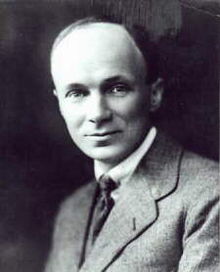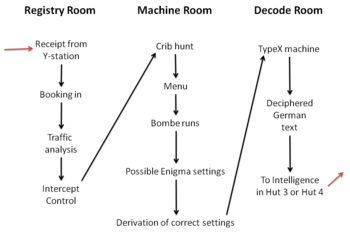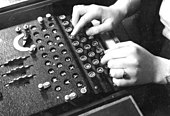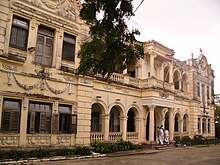Signals intelligence in modern history
Failure to properly protect its communications fatally compromised the Russian Army in its advance early in World War I and led to their disastrous defeat by the Germans under Ludendorff and Hindenburg at the Battle of Tannenberg.
France had significant signals intelligence in World War I. Commandant Cartier developed a system of wireless masts, including one on the Eiffel Tower to intercept German communications.
In the early stages of the war, French intercepts were invaluable for military planning and provided the crucial intelligence to commander-in-chief Joseph Joffre that enabled him to carry out the successful counterattack against the Germans at the Marne in September 1914.
[6] A second important code - the Handelsverkehrsbuch (HVB) codebook used by the German navy - was captured at the very start of the war from the German-Australian steamer Hobart, seized off Port Philip Heads near Melbourne on 11 August 1914.
This was sited at Lowestoft and other stations were built at Lerwick, Aberdeen, York, Flamborough Head and Birchington and by May 1915 the Admiralty was able to track German submarines crossing the North Sea.
A whole string of messages were intercepted during the night indicating with high reliability how the German fleet intended to make good its escape, but the brief summary which was passed to Jellicoe failed to convince him of its accuracy in light of the other failures during the day.
"Warned of a new German raid [on England] on the night of 23–24 January, by radio intercepts, [Admiral Sir David] Beatty’s force made a rendezvous off the Dogger Bank...
The telegram was passed to the U.S. by Captain Hall, and a scheme was devised (involving a still unknown agent in Mexico and a burglary) to conceal how its plaintext had become available and also how the U.S. had gained possession of a copy.
In 1919, the British Cabinet's Secret Service Committee, chaired by Lord Curzon, recommended that a peace-time codebreaking agency should be created, a task given to the then-Director of Naval Intelligence, Hugh Sinclair.
[11] Sinclair merged staff from the British Army's MI1b and Royal Navy's Room 40 into the first peace-time codebreaking agency: the Government Code and Cypher School (GC&CS).
However, in May 1927, during a row over clandestine Soviet support for the General Strike and the distribution of subversive propaganda, Prime Minister Stanley Baldwin made details from the decrypts public.
By 1943, such was the extent of penetration of Axis communications and the speed and efficiency of distribution of the resulting intelligence, messages sometimes reached allied commanders in the field before their intended recipients.
The entire German system of high command suffered from Hitler's deliberate fragmenting of authority, with Party, State, and military organizations competing for power.
Key GC&CS cryptanalysts who moved from London to Bletchley Park included John Tiltman, Dillwyn "Dilly" Knox, Josh Cooper, and Nigel de Grey.
[18][21] In one 1941 recruiting stratagem The Daily Telegraph was asked to organise a crossword competition, after which promising contestants were discreetly approached about "a particular type of work as a contribution to the war effort".
Later-recruited cryptanalysts included the mathematicians Derek Taunt,[25] Jack Good,[26] Bill Tutte,[27] and Max Newman; historian Harry Hinsley, and chess champions Hugh Alexander and Stuart Milner-Barry.
With the help of German operator errors, the cryptanalysts in the Testery (named after Ralph Tester, its head) worked out the logical structure of the machine despite not knowing its physical form.
The "Radio Security Service" was established by MI8 in 1939 to control a network of Direction Finding and intercept stations to locate illicit transmissions coming from German spies in Britain.
The combination of double agents and extensive penetration of German intelligence transmissions facilitated a series of highly successful strategic deception programmes throughout WWII.
Knox was given a new section for work on Enigma variations, which he staffed with women ("Dilly's girls") who included Margaret Rock, Jean Perrin, Clare Harding, Rachel Ronald, Elisabeth Granger; and Mavis Lever[citation needed] who made the first break into the Italian naval traffic.
This led to increased shipping losses and, from reading the intercepted traffic, the team learnt that between May and September 1941 the stock of fuel for the Luftwaffe in North Africa reduced by 90%.
In early 1942, a six-month crash course in Japanese, for 20 undergraduates from Oxford and Cambridge, was started by the Inter-Services Special Intelligence School in Bedford, in a building across from the main Post Office.
[citation needed] In 1999, Michael Smith wrote that: "Only now are the British codebreakers (like John Tiltman, Hugh Foss, and Eric Nave) beginning to receive the recognition they deserve for breaking Japanese codes and cyphers".
[53] Army units in the Pacific included the US 978th Signal Company based at the Allied Intelligence Bureau's secret "Camp X", near Beaudesert, Queensland south of Brisbane.
Soon after the Pearl Harbor attack, Lieutenant Howard Brown, of the 2nd Signal Service Company in Manila, ordered the unit to change its intercept targeting from Japanese diplomatic to air force communications.
Part of the reason for this was that the irregular units that presented the greatest threat did not follow conventional military signal operating procedures, and used nonstandard frequencies and callsigns.
Recognizing that national sources simply might not have information on a given environment, or that they might not make it available to warfighters, Lieutenant General Gray directed that a SIGINT function be created that could work with the elite Force Reconnaissance Marines who search out potential enemies.
General Gray directed that the unit would be called a Radio Reconnaissance Team (RRT), and that adequate planning and preparation were done for the advance force operations part of the upcoming Exercise Solid Shield-85.
According to the retired Commandant of the US Marines, Alfred M. Gray, Jr., some of the significant concerns of these targets are: As a result of the 9/11 attacks, intensification of US intelligence efforts, domestic and foreign, were to be expected.
Further satellites were launched at roughly six-month intervals, and the entire system of this five-satellite synthetic aperture radar constellation achieved full operational readiness on 22 July 2008.









